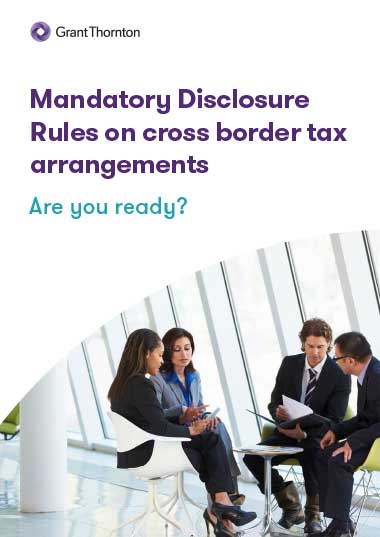-
Sector Focus
We specialise in the investment management industry offering audit, assurance, tax and corporate recovery and liquidation services.
-
Personal Tax Services
There are many tax rules that can affect you personally and therefore which will have an impact on your personal wealth.
-
QI Compliance
Qualified Intermediaries (QI) have to take action now to perform a Certification to the Internal Revenue Service (IRS).
-
Download our tax brochures
The tax teams at Grant Thornton aim to provide the Channel Islands with a premier tax advisory service both to private clients and the business community including the investment management industry.
-
Jersey Tax Return
A secure sign in page to file Jersey Tax Returns through the Grant Thornton tax portal.
-
ESG
ESG can either be seen as a risk management tool or an opportunity, either way it is imperative to your business, whatever your size and whether you are listed or not.
-
Professional Services
Business and accounting support for professional services
-
Finance Industry
We work with a broad range of clients and their financial stakeholders, from entrepreneurs in the early days to fast growing and established businesses to public companies competing in global markets.
-
Local Businesses
Businesses come in many shapes and sizes – from innovative start-ups to long-established local businesses. But however large or small your business, the chances are you face similar challenges.
-
Corporate Insolvency
Our corporate investigation, Guernsey liquidation and recovery teams focus on identifying and resolving issues affecting profitability, protecting enterprise value and facilitating a full recovery where possible.
-
Corporate Simplification
Redundant corporate entities can over complicate group structures and waste thousands of pounds in unnecessary costs each year. 46% of the c.15,500 companies controlled by the FTSE100 are dormant and it is estimated that the average cost of administering dormant companies is between £3,500 and £5,000 per company, per year.
-
Debt Advisory
Our Debt Advisory team provides commercial and financial debt advice to corporate entities and public sector bodies in a range of sectors. Our engagements include advice on stand-alone transactions and solutions or as part of an integrated business plan, in both the project and corporate arenas.
-
Exit Strategy Services
We offer a tailored methodology designed to enable a company to be reviewed in a group context to assess ways to maximise its value.
-
Financial Restructuring
For companies challenged by under-performance we work with management teams, shareholders, lenders and other stakeholders to implement financial restructuring solutions creating a stable platform for business turnaround.
-
Strategic performance reviews
Strategic performance reviews analyse the key drivers of performance improvement. Our specialists utilise a framework to evaluate financial and operational options and to identify solutions for businesses and their stakeholders.
In the near future, we will see the commencement of two new tax regimes, which have the purpose of continuing efforts towards providing visibility to global tax authorities of arrangements which, potentially, could lead to the avoidance of tax.
In the Channel Islands, the Mandatory Disclosure Rules (MDR) will come into effect. These rules are based on OECD rules, designed to prevent the circumventing of Common Reporting Standards (CRS) and to tackle structures which disguise the beneficial owners of offshore structures (Opaque Offshore Structures).
The EU rules on cross border tax arrangements, commonly referred to as DAC6, will take effect in the EU and the UK. These rules are designed to provide EU tax authorities with far greater visibility on cross border arrangements involving at least one EU country, where there is the potential for the tax base to be eroded.
Additional reporting requirements for MDR and DAC6
Both sets of rules bring with them additional reporting requirements for Channel Islands based intermediaries and providers of services to taxpayers, which have cross border elements to their affairs. The strict disclosure requirements and broad scope, in particular of the DAC6, make this one of the most significant changes for service providers and taxpayers in recent years.
The Rules – A Definition
MDR
The MDR requires Channel Islands based intermediaries to report specified information to the Comptroller of Taxes (Jersey) or Guernsey Revenue Services, where it is ‘reasonable to conclude’ that either:
- A structure or arrangement is a CRS avoidance arrangement, which essentially seeks to circumvent CRS Regulations.
- A structure or arrangement is an Opaque Offshore Structure, being a passive offshore vehicle held through an opaque structure, which allows a natural person to be the beneficial owner of that vehicle without the identity of that person being fully identified.
EU Council Directive 2011/16 – Known as DAC6
The application of DAC6 is broader than the MDR. The DAC6 applies where there is a cross border arrangement between taxpayers in two (or more) EU member states, or a taxpayer in one non–EU state and another in an EU state.
The intent is to require reporting to be undertaken by an intermediary, or in some cases the taxpayer directly, to an EU tax authority, where it is believed that an arrangement meets one or more specified ‘hallmarks’. The DAC 6 was originally billed as counteracting extremely aggressive cross border tax planning. However, the text of the final regulations means that what would normally be viewed as fairly standard commercial arrangements, may require reporting.
For example, there can be a need to report cross border financing or rental payments made between related parties, where the recipient is subject to a low/zero rate of tax on the income. To be reportable, one of the categories or ‘hallmarks’ of tax avoidance must be breached - certain hallmarks have built into them a tax avoidance motive test, but others do not; thus further widening the scope of what may need reporting.
A further difficulty under DAC6 is that although it is based on EU rules, the implementation at national level is left up to individual countries, leading to some important differences in what requires to be reported, and by whom. When it comes to MDR and DAC6, in particular the latter, identifying what does, and what does not require reporting, will be difficult. There will undoubtedly be some grey areas in between, which are widely open to interpretation.
Who is responsible for reporting?
Similar provisions under both rules mean that the reporting is due by an ‘intermediary’ which is defined as including both a Promoter, and a Service Provider. Those who will be intermediaries include trust companies, banks, lawyers and tax advisors. There is no get out for not being in the business of providing tax advice.
In certain circumstances, the taxpayer themselves may be required to make a report. For example, under the DAC6, if a Jersey intermediary has no UK nexus (i.e. no office or other presence in the UK), but the arrangement does involve a UK taxpayer, then the requirement to report may fall to the taxpayer directly. Such an intermediary should still decide whether it has a duty to understand that a DAC6 report may be necessary, and advise or assist the taxpayer in making that report.
Thus for a Channel Islands based intermediary, it is important that both the MDR and DAC6 are understood within the business.
What if reporting is missed?
- Financial penalties can apply.
- In some cases, these penalties can be extremely significant.
When is the reporting required?
The DAC6 has been delayed a number of times, but will come into full effect from 1 January 2021. From then, reporting is due on an ongoing basis, being 30 days after the date on which a reporting trigger is met. There is also a backdating requirement, whereby reportable arrangements, which have had their first steps taken since 25 June 2018, require to be included in a report to be made no later than 28 February 2021.
The exact timing of MDR is currently uncertain, but it is anticipated that it will enter into effect at around the same time as the DAC6. Though a degree of backdating can apply under the MDR, it is not such a broad requirement. Given the tight time frames on reporting under both regimes, being in ‘real time’ as opposed to a year end exercise, it is vital that proper processes and procedures are in place to capture these reports timeously.
What are the Next Steps?
It is important that Channel Islands based intermediaries and service providers give both the MDR and DAC6 their attention. There is not much time before reports will be due. Such service providers and intermediaries should:
- Determine the extent to which these rules will impact them;
- Understand situations in which reporting may be required;
- Review any potential backdating of reporting that may be required to facilitate making a full initial report;
- Train staff internally on the rules;
- Ensure written practice/procedures are in place internally;
- Have in place a system for recording when disclosures may be required, and indeed for noting reasons why it is felt no disclosure is required;
- Ensure knowledge of reporting channels is in place.
Our team are ready to support you
Grant Thornton Channel Islands are supporting a number of clients to get ready for these regimes and the reporting requirements they each demand. We can help you ensure that your internal procedures and processes allow for full compliance with the ever increasing demands that stem from each of these regimes.
To discuss these further, please get in contact with our specialists or your usual contact.
Neil Hoolahan – Director, Tax, Guernsey | neil.hoolahan@gt-ci.com | 01481 753 419
Andy Shaw – Senior Manager, Tax, Jersey | andy.shaw@gt-ci.com | 01534 885 704
View other 2020 tax measures
The tax landscape is in a period of hyper change. At Grant Thornton Channel Islands, we are constantly looking for ways to support our clients and service providers so they remain ahead of the game with the ever changing tax legislation and practice.

